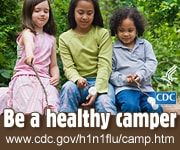How to Prevent Swine Flu

Associated Press/Kin Cheung
A kindergartener in Hong Kong washes her hands before entering her classroom.
Swine flu is similar to seasonal flu in its method of transmission. It is spread from person to person (no swine is involved, so it's perfectly safe to eat pork) via the infected droplets from a cough or a sneeze. After an uncovered cough, the droplets of virus hang in the air, a phenomenon that happens more easily in winter, as a humid summer tends to weigh the droplets down so they fall. When the droplets do land, they are still infectious for up to eight hours [source: CDC].
To keep the infection from spreading, you should always cover your nose and mouth when you sneeze or cough, and throw any used tissues away immediately. Wash your hands with soap and water often; alcohol-based hand cleansers will also take care of the germs. Avoid touching your eyes, nose and mouth so that germy droplets left on objects and surfaces don't have a chance to get close. Most importantly, stay home if you're sick -- no work, no school, no errands, no trips other than the ones to your doctor. The CDC recommends staying home for seven days after your symptoms begin or until you have been symptom-free for 24 hours, whichever is longer.
While you may have only very mild symptoms, it's important to understand that the H1N1 virus might affect the people around you more intensely. You could go to work and infect a male co-worker; he might have mild symptoms as well, but the disease could be immensely dangerous to his pregnant wife. This is one of the reasons why swine flu parties, in which participants gather around someone with a mild form of the disease, are discouraged by public health organizations.
As we've mentioned, the 2009 H1N1 virus may remain mild, or it may become deadly. It's important to maintain a middle ground between panic and complacency. While no one needs to head to their underground bunker, use this as an opportunity to create or revise your family preparedness plan and readiness kit. Such a kit should contain a two-week supply of water, non-perishable food and health supplies.
Sources from here


 How to sew a pillow case
How to sew a pillow case

No comments:
Post a Comment